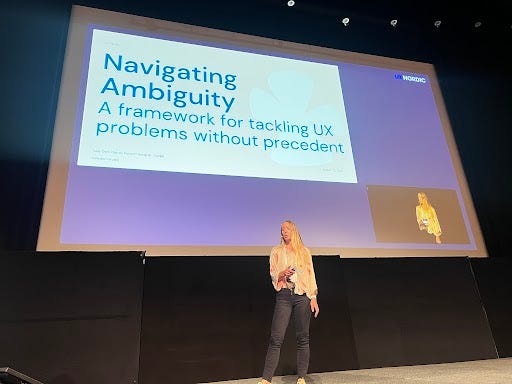AI as a Design Partner 2023 Recap
A year of growth for AI Design Partner: outreach, innovation, and education
2023 was a big year for AI as a Design Partner! I spoke at over 15(!) international design conferences, including in Denmark and Sweden. Launching the AI as a Design Partner newsletter has been a way for me to connect with my audience more frequently and to answer some of the questions that I’ve received from my speaking engagements. I also had some big AI feature launches and announcements, including Duet AI and announced some video AI features. I partnered with DesignLab (where I have been a longtime mentor and coach) to give discounts to new students transitioning into UX design.
AI as a Design Partner 2024 conferences
I am finalizing my speaking engagements for 2024 soon and look forward to sharing with you all. I’m really excited to speak at DDX Dubai and UXDX in 2024.
Some of my AI launches and announcements:
Roundup of some press:
Google Meet’s new AI will be able to go to meetings for you - The Verge
Google’s Duet AI becomes a meeting assistant, doc summarizer and chat companion - Techcrunch
Welcome to the new Google Chat - Workspace Blog
All 161 things we announced at Google Cloud Next ‘23 – a recap - Google Cloud

AI as a Design Partner top posts:
I launched this newsletter as a want to connect more with the community and share what I have been exploring at the intersection of Product inclusion, AI and Design. I’ve focused recently on prompt libraries and how to extend your design workflows using genAI.
Top posts:
From Concrete to Creative: How GenAI Powers Abstraction Laddering for Design Impact
Powering Inclusive User Journeys with AI/ML
When AI Becomes a Crutch in UX Design
Designing for All with Generative AI
Other writing:
I wrote some thoughts on how to navigate ambiguity in the face of a constantly changing landscape.
Defining an ambiguity framework: patterns & principles for uncertainty
Speaking engagements:
I spoke at over 15 global design and user experiences conferences on topics ranging from genAI and product inclusion to how to transition into a career in design. Workshops and conferences have been a way for me to meet a global audience working on a range of areas from automotive to healthcare and everything in between.
A few of my speaking topics:
Defining a product inclusion framework
Navigating ambiguity: My process for tackling problems without precedent
Patterns and principles for responsible AI
AI as a design partner: how to leverage AI to design more inclusively
What is a systems designer: methods, tools and mental models
My 2023 speaking engagements:
SXC2023, Stockholm - Keynote: Scaling and Systematizing Your Design Processes with AI
UI/UX GLOBAL SUMMIT: AI-Powered Design: Scalability and Creativity Sprints in Design
DesignOps Summit: AI as a Design Partner: How to Get the Most Out of AI Tools to Scale Your Process
UXDG: Design in the face of uncertainty: How to thrive in a world of ambiguity
Experience Design Summit: Navigating ambiguity: My process for tackling problems
UX Nordic, Denmark: AI-Powered Inclusive Design (workshop and Q&A session at the conference)
UX Nordic, Denmark: Navigating ambiguity: A framework for tackling UX problems
Many internal Google Summits, workshops and conferences
Partnership with DesignLab
I also became an education partner with DesignLab to support new designers transitioning from other careers. I have written about how designers can build a compelling portfolio without client work.
What I’m excited about for 2024
I can't wait to see the magic unfold in generative AI design next year. Here are the 3 groundbreaking trends I'm most excited about witnessing in 2024, and why I believe they'll have a profound impact on the field.
Better genAI-powered tools for UX designers to manage design systems. Boosting design efficiency and team alignment, minimizing errors, and ensuring brand consistency across projects
More UI layers on top of LLMs to visualize conversational AI inputs. Perplexity AI is doing this well as a way to visually communicate information between LLMs to interfaces.
Better training and guardrails for LLMs to avoid bias and exclusion. Providing diverse training data, incorporating fairness metrics into feedback loops, and developing human-in-the-loop approaches can mitigate bias and promote responsible AI development.
Thank you for a wonderful 2023 and I look forward to connecting more with this community in 2024!









